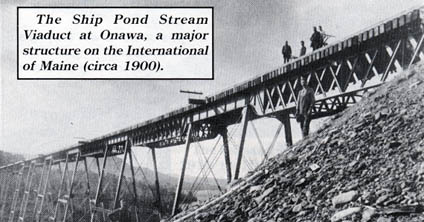Vol. 17 No. 8
August, 1987
|
Stay Safe in 87
|
|

Building the
"International
of Maine"
|

Omer Lavallee
|

With the completion of the transcontinental line
behind it, Canadian Pacific began, in 1886, to look to the extension of the line to an ice-free winter
port.
Earlier, in 1883, the company had begun to obtain control of local lines and charters in the Eastern Townships of
Quebec. The chief of these was the South Eastern Railway (SER), with headquarters at Farnham.
The SER 's main line extended between Farnham and Newport, with branches to Drummondville, St. Guillaume, and
Stanbridge. Another component was the Waterloo & Magog Railway (W&M), which extended between Waterloo and
Sherbrooke via Eastman and Magog.
The building of the Short Line began in earnest in 1886. Contracts were let for the building of a new main line -
the present Adirondack and Sherbrooke subdivisions - between Montreal and Lennoxville. Strictly speaking, the line
was not all new; it used a section of the SER between Farnham and Brookport, and some short sections of the W&M
around Eastman and Magog. The line between Montreal and Sherbrooke opened 6 Aug 1888.
The CPR acquired control of the International Railway in 1886 by purchase of its entire capital stock. This action
also gave it possession of the charter and properties of the International Railway of Maine. In the course of that
year, the final location survey, extending for 207 kilometres between Gulf Stream near Holeb and a connection with
the Maine Central at Mattawamkeag, was made by Alexander Middleton.
Construction of the whole line between Montreal and Mattawamkeag was put in charge of James Ross, who had built the
transcontinental railway across the prairies and through the western mountains as far as Eagle Pass. However, Ross
relinquished the post in mid-1887 to take a contract himself. He was replaced by Hugh Lumsden, who had
been in charge of construction of the line between Smiths Falls and Montreal, which had just been completed.
Tenders for the section in Maine were invited in the spring of 1887. The bids closed 26 Apr 1887 when
nine contracts - averaging 23 kilometres each - were awarded for the clearing and construction of the
sub-grade. It's worthy of note that contracts four and six were awarded, respectively, to William
Mackenzie and Donald Mann.
WORK TACKLED ON SIX FRONTS
As many readers know, Mackenzie and Mann went on to build the Canadian Northern system, a major component of what is
now Canadian National.
Access for construction of the line was afforded not only at its extremeties: the International's railhead
near Holeb and the Maine Central (MeC) at Mattawamkeag, but also via the Bangor & Piscataquis (later Bangor
& Aroostook) at Greenville and at Brownville. Thus, there were six "fronts" from which to tackle the
work.
Unskilled labourers were paid $1.50 a day, but skilled workers, such as blacksmiths, stonecutters, and stonemasons
earned between $2.50 and $3.00. Many of the stone craftsmen were Italians, whose dietary preferences, according to a
local newspaper, consisted " ...of bread, pea soup, macaroni, and bologna sausage (which) is varied frequently
by a stew of frog's legs which animals are found in immense numbers on the border of Moosehead Lake".
Much difficulty was caused by an initial decision to classify excavated material into only three categories - rock,
loose rock, and earth. These classifications omitted "hard pan" or "calcrete", a hardened or
cemented layer found in certain soils.
The contractors, led by Mackenzie, objected that they were losing money by being paid insufficiently for work in
this category, and threatened to abandon their contracts and stop the work.
The company hired R.G. Reid to do an inspection, which he did in the autumn of 1887. His subsequent recommendations
were adopted, though not before one of the contractors - Starrs, Askwith & Company - had been forced into
bankruptcy. Mackenzie and Mann recalled in later years that they "did not lose anything or make anything"
on their contracts.
In the spring of 1888, five locomotives and crews were assigned to work with tracklaying and ballasting trains on
various sections of the International of Maine. Four of them sent to Bangor by way of Newport and Portland, Maine,
were distributed as follows: two to Greenville, one to Brownville, and one to Mattawamkeag. The fifth
locomotive and crew sent over the completed line to the railhead at Holeb.
The first rails for the line were received by ship from American mills at Saint John in June 1888. By the beginning
of August, 86 kilometres of track had been put down.
Next week, we'll tell about the last spike and the opening of the line.
This CP Rail News article is copyright
1987 by the Canadian Pacific Railway and is reprinted here with
their permission. All photographs, logos, and trademarks are the property of the Canadian Pacific Railway
Company.
|